Strategic Human Resource Management Report: HRM Practices & Goals
VerifiedAdded on 2020/02/05
|10
|2662
|294
Report
AI Summary
This report delves into the realm of Strategic Human Resource Management (SHRM), providing a comprehensive overview of its core concepts, models, and practical applications. The report begins by defining HRM and SHRM, highlighting their roles in achieving organizational objectives through strategic planning and human capital management. It then explores the changing perspectives of SHRM, differentiating between hard and soft HRM models and their impact on employee engagement and competitive advantage. The report introduces various SHRM models, including staffing, performance management, and reward systems. Furthermore, it examines the impact of HR practices on organizational goals, using a case study of Tesco to illustrate how leadership development, training, and employee communication contribute to success. The analysis emphasizes the significance of SHRM in fostering a skilled and motivated workforce, ultimately driving organizational growth and adaptability.
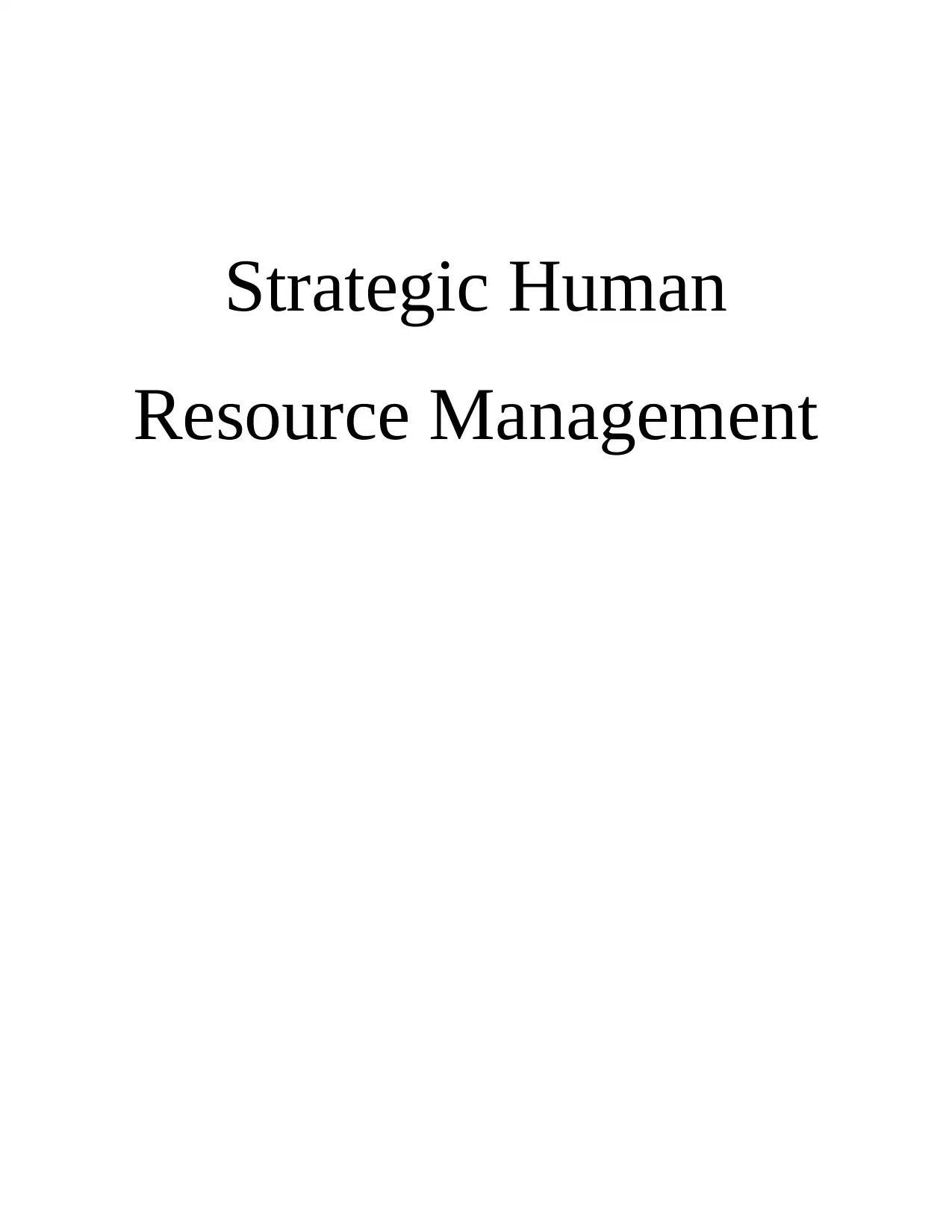
Strategic Human
Resource Management
Resource Management
Paraphrase This Document
Need a fresh take? Get an instant paraphrase of this document with our AI Paraphraser
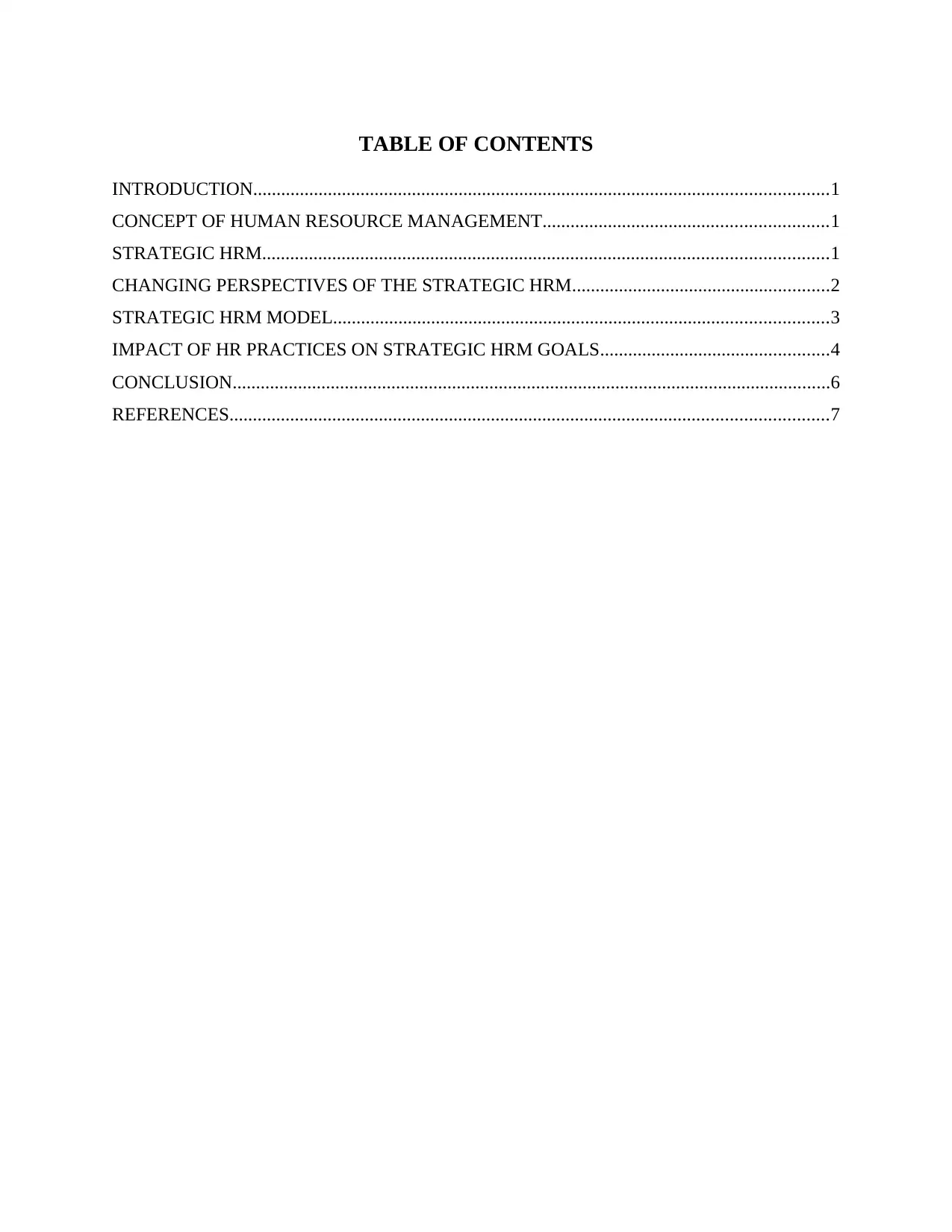
TABLE OF CONTENTS
INTRODUCTION...........................................................................................................................1
CONCEPT OF HUMAN RESOURCE MANAGEMENT.............................................................1
STRATEGIC HRM.........................................................................................................................1
CHANGING PERSPECTIVES OF THE STRATEGIC HRM.......................................................2
STRATEGIC HRM MODEL..........................................................................................................3
IMPACT OF HR PRACTICES ON STRATEGIC HRM GOALS.................................................4
CONCLUSION................................................................................................................................6
REFERENCES................................................................................................................................7
INTRODUCTION...........................................................................................................................1
CONCEPT OF HUMAN RESOURCE MANAGEMENT.............................................................1
STRATEGIC HRM.........................................................................................................................1
CHANGING PERSPECTIVES OF THE STRATEGIC HRM.......................................................2
STRATEGIC HRM MODEL..........................................................................................................3
IMPACT OF HR PRACTICES ON STRATEGIC HRM GOALS.................................................4
CONCLUSION................................................................................................................................6
REFERENCES................................................................................................................................7
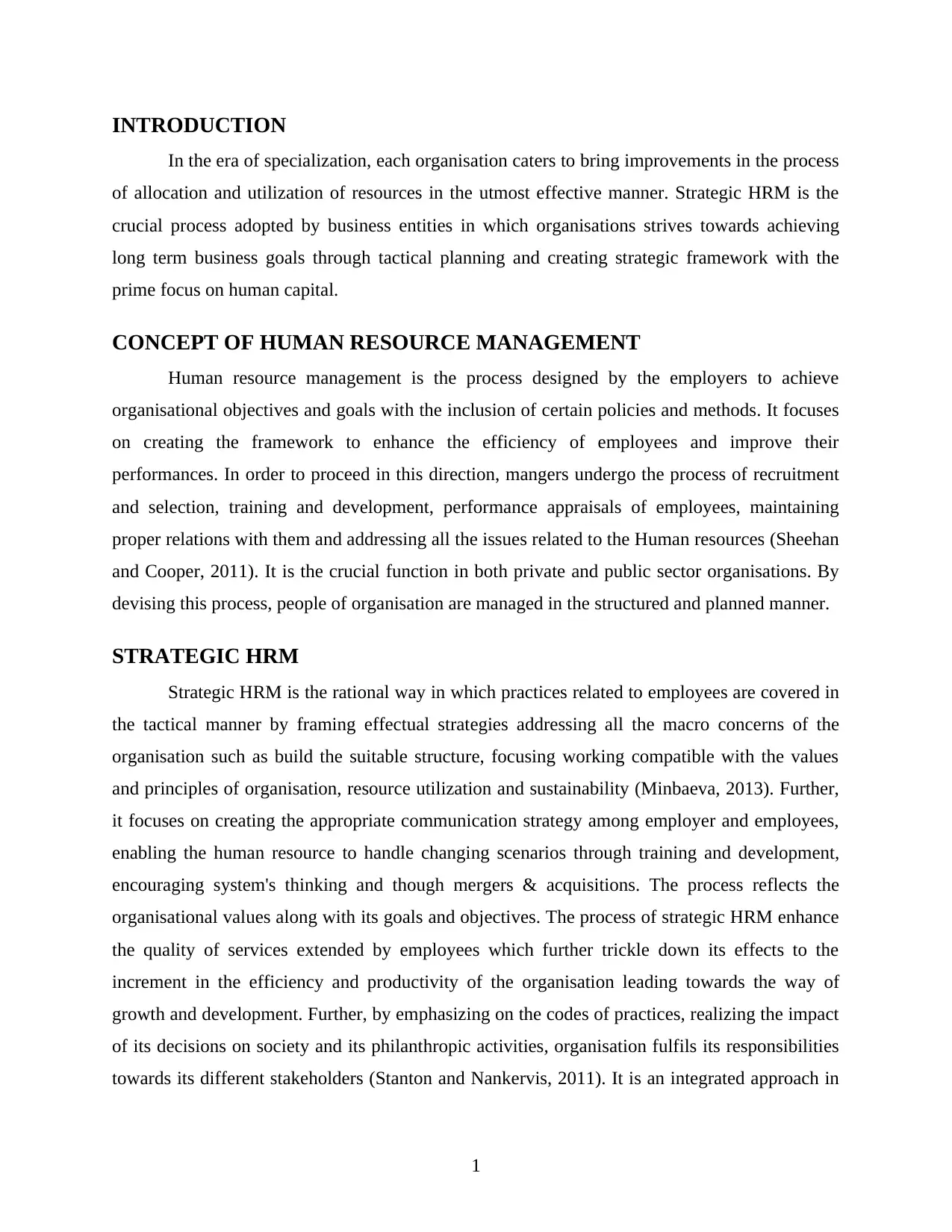
INTRODUCTION
In the era of specialization, each organisation caters to bring improvements in the process
of allocation and utilization of resources in the utmost effective manner. Strategic HRM is the
crucial process adopted by business entities in which organisations strives towards achieving
long term business goals through tactical planning and creating strategic framework with the
prime focus on human capital.
CONCEPT OF HUMAN RESOURCE MANAGEMENT
Human resource management is the process designed by the employers to achieve
organisational objectives and goals with the inclusion of certain policies and methods. It focuses
on creating the framework to enhance the efficiency of employees and improve their
performances. In order to proceed in this direction, mangers undergo the process of recruitment
and selection, training and development, performance appraisals of employees, maintaining
proper relations with them and addressing all the issues related to the Human resources (Sheehan
and Cooper, 2011). It is the crucial function in both private and public sector organisations. By
devising this process, people of organisation are managed in the structured and planned manner.
STRATEGIC HRM
Strategic HRM is the rational way in which practices related to employees are covered in
the tactical manner by framing effectual strategies addressing all the macro concerns of the
organisation such as build the suitable structure, focusing working compatible with the values
and principles of organisation, resource utilization and sustainability (Minbaeva, 2013). Further,
it focuses on creating the appropriate communication strategy among employer and employees,
enabling the human resource to handle changing scenarios through training and development,
encouraging system's thinking and though mergers & acquisitions. The process reflects the
organisational values along with its goals and objectives. The process of strategic HRM enhance
the quality of services extended by employees which further trickle down its effects to the
increment in the efficiency and productivity of the organisation leading towards the way of
growth and development. Further, by emphasizing on the codes of practices, realizing the impact
of its decisions on society and its philanthropic activities, organisation fulfils its responsibilities
towards its different stakeholders (Stanton and Nankervis, 2011). It is an integrated approach in
1
In the era of specialization, each organisation caters to bring improvements in the process
of allocation and utilization of resources in the utmost effective manner. Strategic HRM is the
crucial process adopted by business entities in which organisations strives towards achieving
long term business goals through tactical planning and creating strategic framework with the
prime focus on human capital.
CONCEPT OF HUMAN RESOURCE MANAGEMENT
Human resource management is the process designed by the employers to achieve
organisational objectives and goals with the inclusion of certain policies and methods. It focuses
on creating the framework to enhance the efficiency of employees and improve their
performances. In order to proceed in this direction, mangers undergo the process of recruitment
and selection, training and development, performance appraisals of employees, maintaining
proper relations with them and addressing all the issues related to the Human resources (Sheehan
and Cooper, 2011). It is the crucial function in both private and public sector organisations. By
devising this process, people of organisation are managed in the structured and planned manner.
STRATEGIC HRM
Strategic HRM is the rational way in which practices related to employees are covered in
the tactical manner by framing effectual strategies addressing all the macro concerns of the
organisation such as build the suitable structure, focusing working compatible with the values
and principles of organisation, resource utilization and sustainability (Minbaeva, 2013). Further,
it focuses on creating the appropriate communication strategy among employer and employees,
enabling the human resource to handle changing scenarios through training and development,
encouraging system's thinking and though mergers & acquisitions. The process reflects the
organisational values along with its goals and objectives. The process of strategic HRM enhance
the quality of services extended by employees which further trickle down its effects to the
increment in the efficiency and productivity of the organisation leading towards the way of
growth and development. Further, by emphasizing on the codes of practices, realizing the impact
of its decisions on society and its philanthropic activities, organisation fulfils its responsibilities
towards its different stakeholders (Stanton and Nankervis, 2011). It is an integrated approach in
1
⊘ This is a preview!⊘
Do you want full access?
Subscribe today to unlock all pages.

Trusted by 1+ million students worldwide
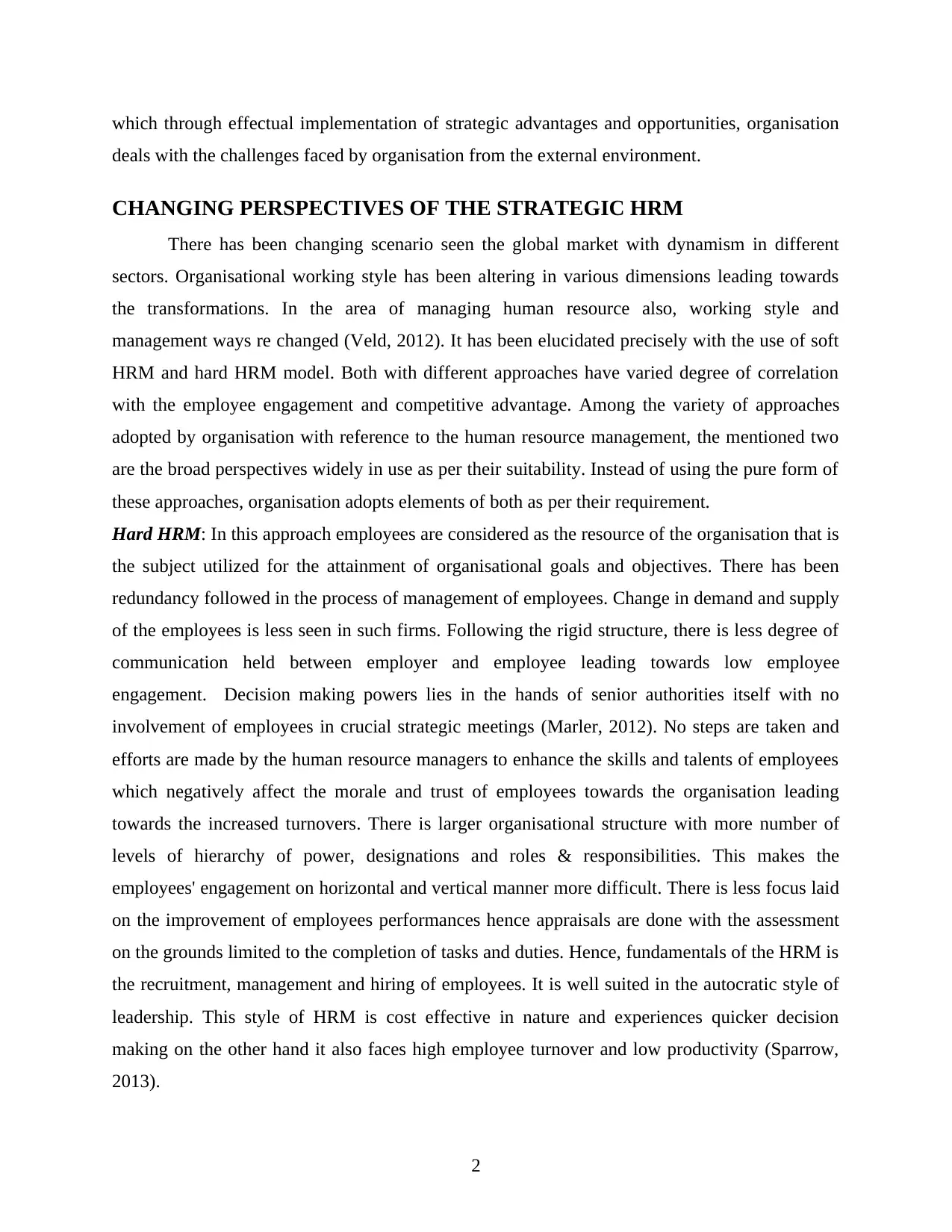
which through effectual implementation of strategic advantages and opportunities, organisation
deals with the challenges faced by organisation from the external environment.
CHANGING PERSPECTIVES OF THE STRATEGIC HRM
There has been changing scenario seen the global market with dynamism in different
sectors. Organisational working style has been altering in various dimensions leading towards
the transformations. In the area of managing human resource also, working style and
management ways re changed (Veld, 2012). It has been elucidated precisely with the use of soft
HRM and hard HRM model. Both with different approaches have varied degree of correlation
with the employee engagement and competitive advantage. Among the variety of approaches
adopted by organisation with reference to the human resource management, the mentioned two
are the broad perspectives widely in use as per their suitability. Instead of using the pure form of
these approaches, organisation adopts elements of both as per their requirement.
Hard HRM: In this approach employees are considered as the resource of the organisation that is
the subject utilized for the attainment of organisational goals and objectives. There has been
redundancy followed in the process of management of employees. Change in demand and supply
of the employees is less seen in such firms. Following the rigid structure, there is less degree of
communication held between employer and employee leading towards low employee
engagement. Decision making powers lies in the hands of senior authorities itself with no
involvement of employees in crucial strategic meetings (Marler, 2012). No steps are taken and
efforts are made by the human resource managers to enhance the skills and talents of employees
which negatively affect the morale and trust of employees towards the organisation leading
towards the increased turnovers. There is larger organisational structure with more number of
levels of hierarchy of power, designations and roles & responsibilities. This makes the
employees' engagement on horizontal and vertical manner more difficult. There is less focus laid
on the improvement of employees performances hence appraisals are done with the assessment
on the grounds limited to the completion of tasks and duties. Hence, fundamentals of the HRM is
the recruitment, management and hiring of employees. It is well suited in the autocratic style of
leadership. This style of HRM is cost effective in nature and experiences quicker decision
making on the other hand it also faces high employee turnover and low productivity (Sparrow,
2013).
2
deals with the challenges faced by organisation from the external environment.
CHANGING PERSPECTIVES OF THE STRATEGIC HRM
There has been changing scenario seen the global market with dynamism in different
sectors. Organisational working style has been altering in various dimensions leading towards
the transformations. In the area of managing human resource also, working style and
management ways re changed (Veld, 2012). It has been elucidated precisely with the use of soft
HRM and hard HRM model. Both with different approaches have varied degree of correlation
with the employee engagement and competitive advantage. Among the variety of approaches
adopted by organisation with reference to the human resource management, the mentioned two
are the broad perspectives widely in use as per their suitability. Instead of using the pure form of
these approaches, organisation adopts elements of both as per their requirement.
Hard HRM: In this approach employees are considered as the resource of the organisation that is
the subject utilized for the attainment of organisational goals and objectives. There has been
redundancy followed in the process of management of employees. Change in demand and supply
of the employees is less seen in such firms. Following the rigid structure, there is less degree of
communication held between employer and employee leading towards low employee
engagement. Decision making powers lies in the hands of senior authorities itself with no
involvement of employees in crucial strategic meetings (Marler, 2012). No steps are taken and
efforts are made by the human resource managers to enhance the skills and talents of employees
which negatively affect the morale and trust of employees towards the organisation leading
towards the increased turnovers. There is larger organisational structure with more number of
levels of hierarchy of power, designations and roles & responsibilities. This makes the
employees' engagement on horizontal and vertical manner more difficult. There is less focus laid
on the improvement of employees performances hence appraisals are done with the assessment
on the grounds limited to the completion of tasks and duties. Hence, fundamentals of the HRM is
the recruitment, management and hiring of employees. It is well suited in the autocratic style of
leadership. This style of HRM is cost effective in nature and experiences quicker decision
making on the other hand it also faces high employee turnover and low productivity (Sparrow,
2013).
2
Paraphrase This Document
Need a fresh take? Get an instant paraphrase of this document with our AI Paraphraser
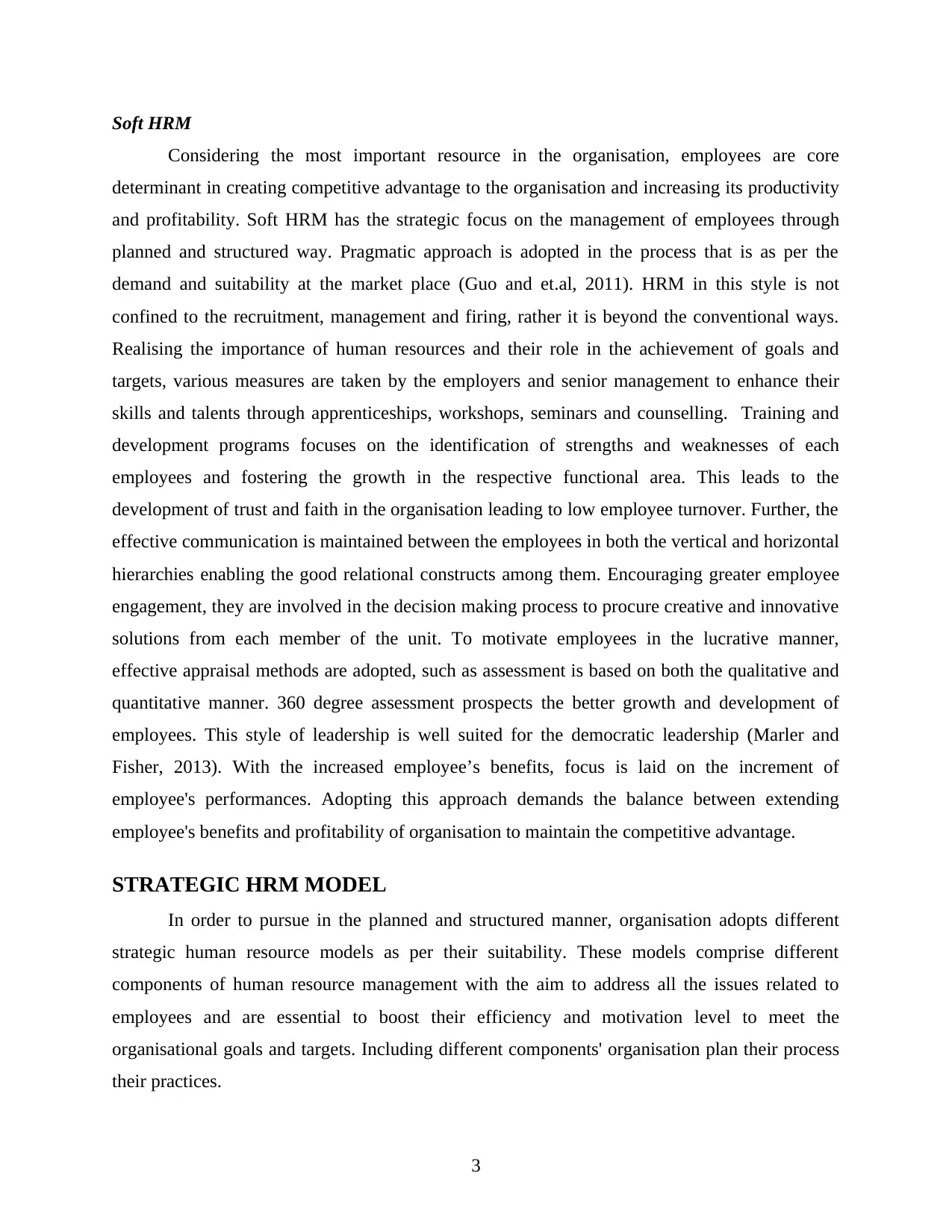
Soft HRM
Considering the most important resource in the organisation, employees are core
determinant in creating competitive advantage to the organisation and increasing its productivity
and profitability. Soft HRM has the strategic focus on the management of employees through
planned and structured way. Pragmatic approach is adopted in the process that is as per the
demand and suitability at the market place (Guo and et.al, 2011). HRM in this style is not
confined to the recruitment, management and firing, rather it is beyond the conventional ways.
Realising the importance of human resources and their role in the achievement of goals and
targets, various measures are taken by the employers and senior management to enhance their
skills and talents through apprenticeships, workshops, seminars and counselling. Training and
development programs focuses on the identification of strengths and weaknesses of each
employees and fostering the growth in the respective functional area. This leads to the
development of trust and faith in the organisation leading to low employee turnover. Further, the
effective communication is maintained between the employees in both the vertical and horizontal
hierarchies enabling the good relational constructs among them. Encouraging greater employee
engagement, they are involved in the decision making process to procure creative and innovative
solutions from each member of the unit. To motivate employees in the lucrative manner,
effective appraisal methods are adopted, such as assessment is based on both the qualitative and
quantitative manner. 360 degree assessment prospects the better growth and development of
employees. This style of leadership is well suited for the democratic leadership (Marler and
Fisher, 2013). With the increased employee’s benefits, focus is laid on the increment of
employee's performances. Adopting this approach demands the balance between extending
employee's benefits and profitability of organisation to maintain the competitive advantage.
STRATEGIC HRM MODEL
In order to pursue in the planned and structured manner, organisation adopts different
strategic human resource models as per their suitability. These models comprise different
components of human resource management with the aim to address all the issues related to
employees and are essential to boost their efficiency and motivation level to meet the
organisational goals and targets. Including different components' organisation plan their process
their practices.
3
Considering the most important resource in the organisation, employees are core
determinant in creating competitive advantage to the organisation and increasing its productivity
and profitability. Soft HRM has the strategic focus on the management of employees through
planned and structured way. Pragmatic approach is adopted in the process that is as per the
demand and suitability at the market place (Guo and et.al, 2011). HRM in this style is not
confined to the recruitment, management and firing, rather it is beyond the conventional ways.
Realising the importance of human resources and their role in the achievement of goals and
targets, various measures are taken by the employers and senior management to enhance their
skills and talents through apprenticeships, workshops, seminars and counselling. Training and
development programs focuses on the identification of strengths and weaknesses of each
employees and fostering the growth in the respective functional area. This leads to the
development of trust and faith in the organisation leading to low employee turnover. Further, the
effective communication is maintained between the employees in both the vertical and horizontal
hierarchies enabling the good relational constructs among them. Encouraging greater employee
engagement, they are involved in the decision making process to procure creative and innovative
solutions from each member of the unit. To motivate employees in the lucrative manner,
effective appraisal methods are adopted, such as assessment is based on both the qualitative and
quantitative manner. 360 degree assessment prospects the better growth and development of
employees. This style of leadership is well suited for the democratic leadership (Marler and
Fisher, 2013). With the increased employee’s benefits, focus is laid on the increment of
employee's performances. Adopting this approach demands the balance between extending
employee's benefits and profitability of organisation to maintain the competitive advantage.
STRATEGIC HRM MODEL
In order to pursue in the planned and structured manner, organisation adopts different
strategic human resource models as per their suitability. These models comprise different
components of human resource management with the aim to address all the issues related to
employees and are essential to boost their efficiency and motivation level to meet the
organisational goals and targets. Including different components' organisation plan their process
their practices.
3
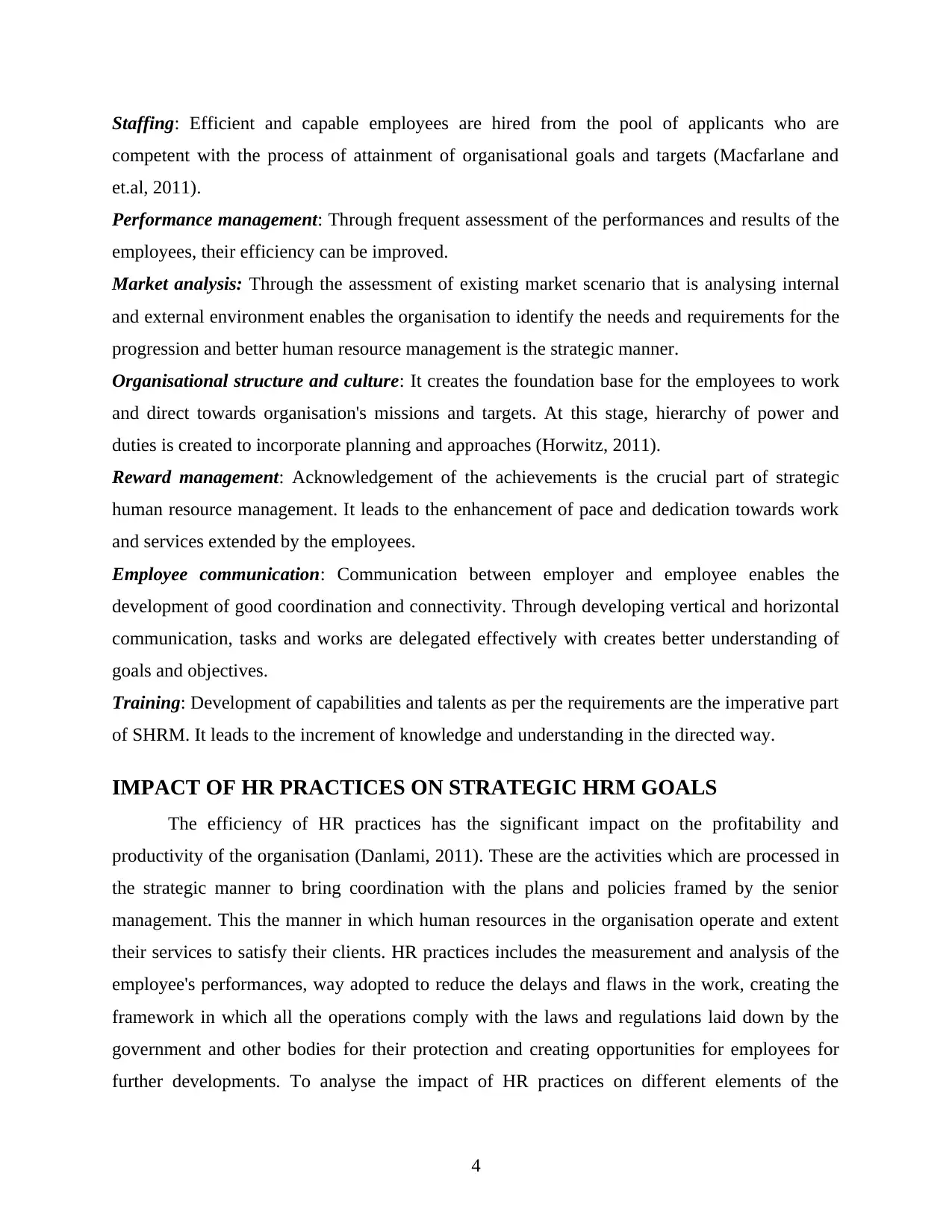
Staffing: Efficient and capable employees are hired from the pool of applicants who are
competent with the process of attainment of organisational goals and targets (Macfarlane and
et.al, 2011).
Performance management: Through frequent assessment of the performances and results of the
employees, their efficiency can be improved.
Market analysis: Through the assessment of existing market scenario that is analysing internal
and external environment enables the organisation to identify the needs and requirements for the
progression and better human resource management is the strategic manner.
Organisational structure and culture: It creates the foundation base for the employees to work
and direct towards organisation's missions and targets. At this stage, hierarchy of power and
duties is created to incorporate planning and approaches (Horwitz, 2011).
Reward management: Acknowledgement of the achievements is the crucial part of strategic
human resource management. It leads to the enhancement of pace and dedication towards work
and services extended by the employees.
Employee communication: Communication between employer and employee enables the
development of good coordination and connectivity. Through developing vertical and horizontal
communication, tasks and works are delegated effectively with creates better understanding of
goals and objectives.
Training: Development of capabilities and talents as per the requirements are the imperative part
of SHRM. It leads to the increment of knowledge and understanding in the directed way.
IMPACT OF HR PRACTICES ON STRATEGIC HRM GOALS
The efficiency of HR practices has the significant impact on the profitability and
productivity of the organisation (Danlami, 2011). These are the activities which are processed in
the strategic manner to bring coordination with the plans and policies framed by the senior
management. This the manner in which human resources in the organisation operate and extent
their services to satisfy their clients. HR practices includes the measurement and analysis of the
employee's performances, way adopted to reduce the delays and flaws in the work, creating the
framework in which all the operations comply with the laws and regulations laid down by the
government and other bodies for their protection and creating opportunities for employees for
further developments. To analyse the impact of HR practices on different elements of the
4
competent with the process of attainment of organisational goals and targets (Macfarlane and
et.al, 2011).
Performance management: Through frequent assessment of the performances and results of the
employees, their efficiency can be improved.
Market analysis: Through the assessment of existing market scenario that is analysing internal
and external environment enables the organisation to identify the needs and requirements for the
progression and better human resource management is the strategic manner.
Organisational structure and culture: It creates the foundation base for the employees to work
and direct towards organisation's missions and targets. At this stage, hierarchy of power and
duties is created to incorporate planning and approaches (Horwitz, 2011).
Reward management: Acknowledgement of the achievements is the crucial part of strategic
human resource management. It leads to the enhancement of pace and dedication towards work
and services extended by the employees.
Employee communication: Communication between employer and employee enables the
development of good coordination and connectivity. Through developing vertical and horizontal
communication, tasks and works are delegated effectively with creates better understanding of
goals and objectives.
Training: Development of capabilities and talents as per the requirements are the imperative part
of SHRM. It leads to the increment of knowledge and understanding in the directed way.
IMPACT OF HR PRACTICES ON STRATEGIC HRM GOALS
The efficiency of HR practices has the significant impact on the profitability and
productivity of the organisation (Danlami, 2011). These are the activities which are processed in
the strategic manner to bring coordination with the plans and policies framed by the senior
management. This the manner in which human resources in the organisation operate and extent
their services to satisfy their clients. HR practices includes the measurement and analysis of the
employee's performances, way adopted to reduce the delays and flaws in the work, creating the
framework in which all the operations comply with the laws and regulations laid down by the
government and other bodies for their protection and creating opportunities for employees for
further developments. To analyse the impact of HR practices on different elements of the
4
⊘ This is a preview!⊘
Do you want full access?
Subscribe today to unlock all pages.

Trusted by 1+ million students worldwide
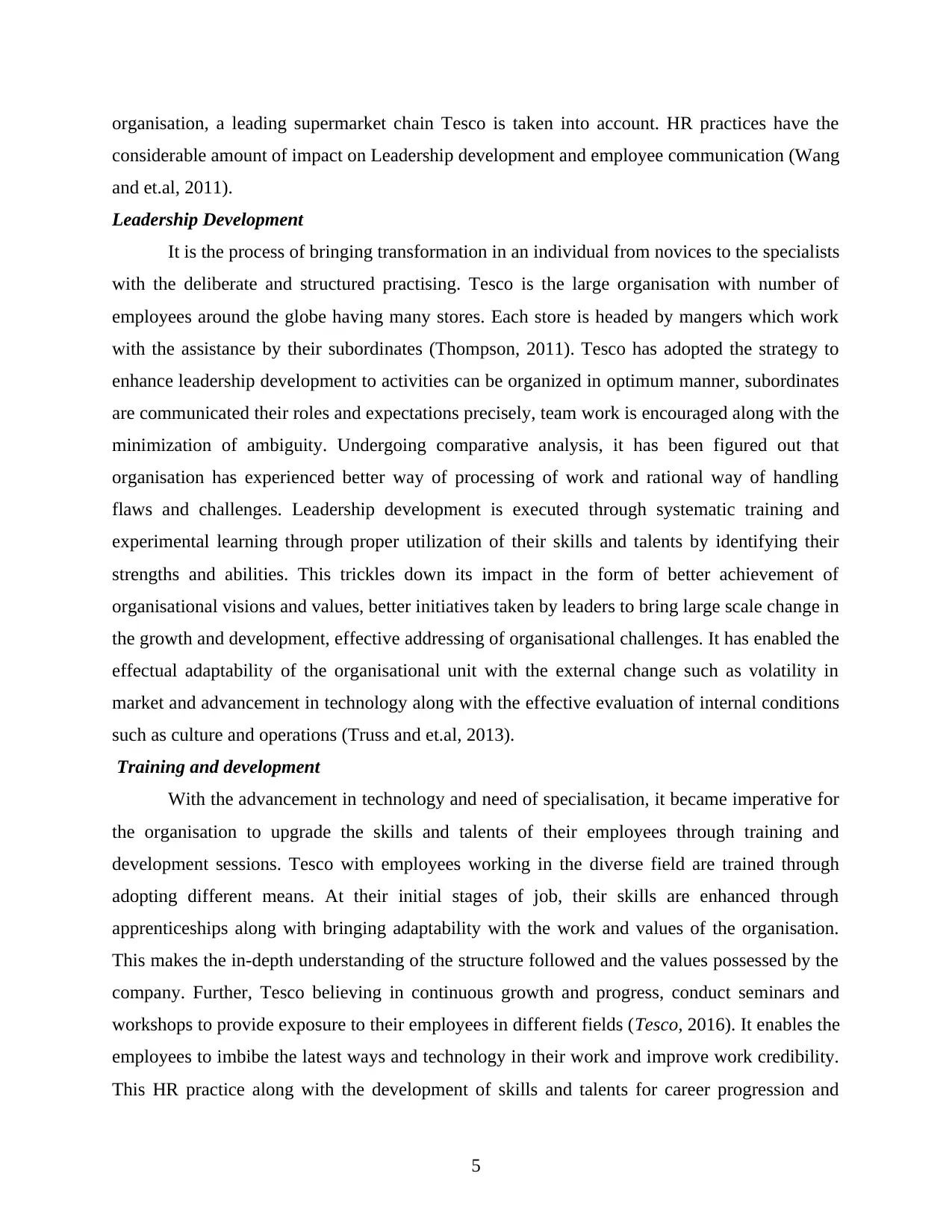
organisation, a leading supermarket chain Tesco is taken into account. HR practices have the
considerable amount of impact on Leadership development and employee communication (Wang
and et.al, 2011).
Leadership Development
It is the process of bringing transformation in an individual from novices to the specialists
with the deliberate and structured practising. Tesco is the large organisation with number of
employees around the globe having many stores. Each store is headed by mangers which work
with the assistance by their subordinates (Thompson, 2011). Tesco has adopted the strategy to
enhance leadership development to activities can be organized in optimum manner, subordinates
are communicated their roles and expectations precisely, team work is encouraged along with the
minimization of ambiguity. Undergoing comparative analysis, it has been figured out that
organisation has experienced better way of processing of work and rational way of handling
flaws and challenges. Leadership development is executed through systematic training and
experimental learning through proper utilization of their skills and talents by identifying their
strengths and abilities. This trickles down its impact in the form of better achievement of
organisational visions and values, better initiatives taken by leaders to bring large scale change in
the growth and development, effective addressing of organisational challenges. It has enabled the
effectual adaptability of the organisational unit with the external change such as volatility in
market and advancement in technology along with the effective evaluation of internal conditions
such as culture and operations (Truss and et.al, 2013).
Training and development
With the advancement in technology and need of specialisation, it became imperative for
the organisation to upgrade the skills and talents of their employees through training and
development sessions. Tesco with employees working in the diverse field are trained through
adopting different means. At their initial stages of job, their skills are enhanced through
apprenticeships along with bringing adaptability with the work and values of the organisation.
This makes the in-depth understanding of the structure followed and the values possessed by the
company. Further, Tesco believing in continuous growth and progress, conduct seminars and
workshops to provide exposure to their employees in different fields (Tesco, 2016). It enables the
employees to imbibe the latest ways and technology in their work and improve work credibility.
This HR practice along with the development of skills and talents for career progression and
5
considerable amount of impact on Leadership development and employee communication (Wang
and et.al, 2011).
Leadership Development
It is the process of bringing transformation in an individual from novices to the specialists
with the deliberate and structured practising. Tesco is the large organisation with number of
employees around the globe having many stores. Each store is headed by mangers which work
with the assistance by their subordinates (Thompson, 2011). Tesco has adopted the strategy to
enhance leadership development to activities can be organized in optimum manner, subordinates
are communicated their roles and expectations precisely, team work is encouraged along with the
minimization of ambiguity. Undergoing comparative analysis, it has been figured out that
organisation has experienced better way of processing of work and rational way of handling
flaws and challenges. Leadership development is executed through systematic training and
experimental learning through proper utilization of their skills and talents by identifying their
strengths and abilities. This trickles down its impact in the form of better achievement of
organisational visions and values, better initiatives taken by leaders to bring large scale change in
the growth and development, effective addressing of organisational challenges. It has enabled the
effectual adaptability of the organisational unit with the external change such as volatility in
market and advancement in technology along with the effective evaluation of internal conditions
such as culture and operations (Truss and et.al, 2013).
Training and development
With the advancement in technology and need of specialisation, it became imperative for
the organisation to upgrade the skills and talents of their employees through training and
development sessions. Tesco with employees working in the diverse field are trained through
adopting different means. At their initial stages of job, their skills are enhanced through
apprenticeships along with bringing adaptability with the work and values of the organisation.
This makes the in-depth understanding of the structure followed and the values possessed by the
company. Further, Tesco believing in continuous growth and progress, conduct seminars and
workshops to provide exposure to their employees in different fields (Tesco, 2016). It enables the
employees to imbibe the latest ways and technology in their work and improve work credibility.
This HR practice along with the development of skills and talents for career progression and
5
Paraphrase This Document
Need a fresh take? Get an instant paraphrase of this document with our AI Paraphraser
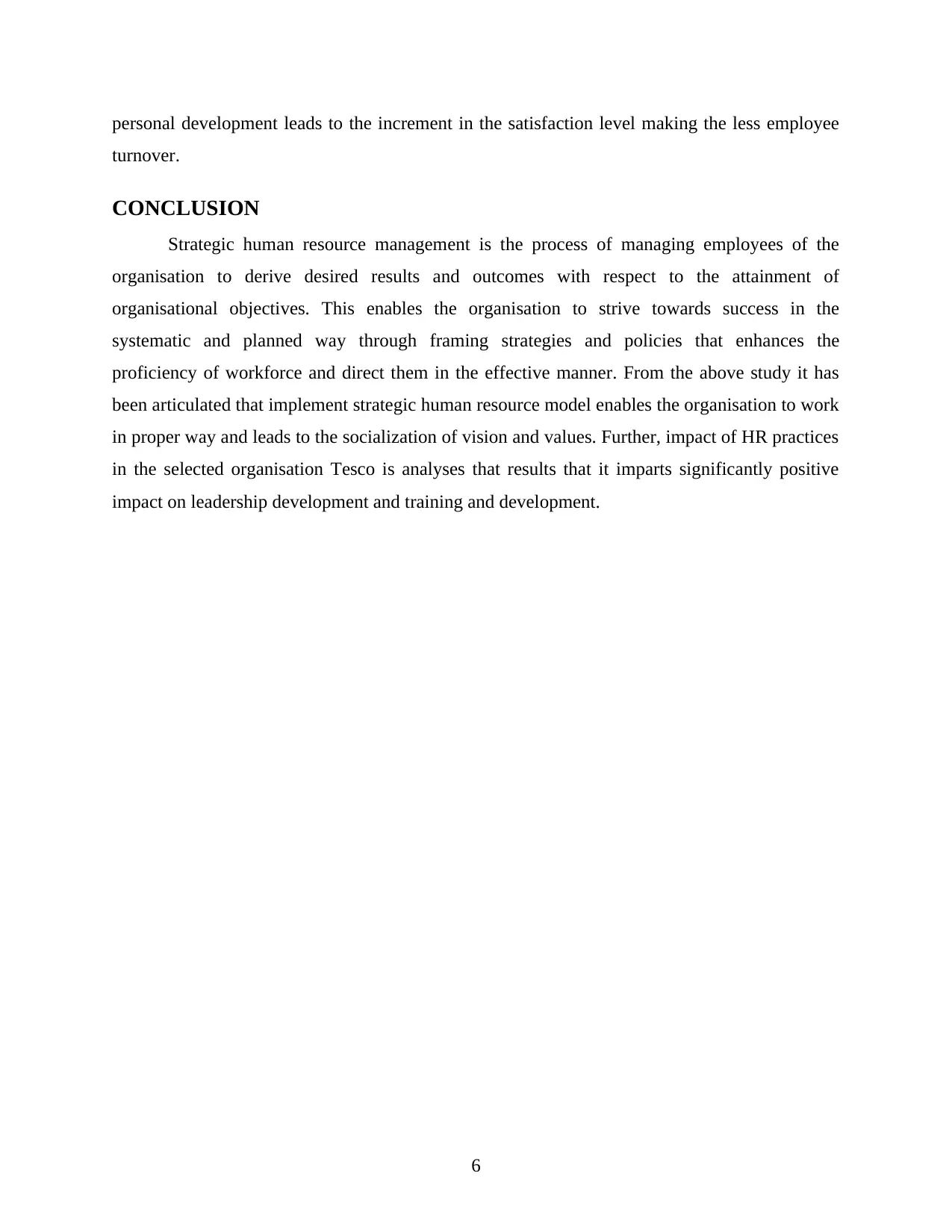
personal development leads to the increment in the satisfaction level making the less employee
turnover.
CONCLUSION
Strategic human resource management is the process of managing employees of the
organisation to derive desired results and outcomes with respect to the attainment of
organisational objectives. This enables the organisation to strive towards success in the
systematic and planned way through framing strategies and policies that enhances the
proficiency of workforce and direct them in the effective manner. From the above study it has
been articulated that implement strategic human resource model enables the organisation to work
in proper way and leads to the socialization of vision and values. Further, impact of HR practices
in the selected organisation Tesco is analyses that results that it imparts significantly positive
impact on leadership development and training and development.
6
turnover.
CONCLUSION
Strategic human resource management is the process of managing employees of the
organisation to derive desired results and outcomes with respect to the attainment of
organisational objectives. This enables the organisation to strive towards success in the
systematic and planned way through framing strategies and policies that enhances the
proficiency of workforce and direct them in the effective manner. From the above study it has
been articulated that implement strategic human resource model enables the organisation to work
in proper way and leads to the socialization of vision and values. Further, impact of HR practices
in the selected organisation Tesco is analyses that results that it imparts significantly positive
impact on leadership development and training and development.
6

REFERENCES
Books and Journals
Danlami, A.S., 2011. Strategic human resource management and organizational performance in
the Nigerian manufacturing sector: An empirical investigation. International Journal of
Business and Management. 6(9). p.46.
Guo, C. and et.al., 2011. Strategic human resources management in nonprofit
organizations.Review of Public Personnel Administration. 31(3). pp.248-269.
Horwitz, F.M., 2011. Future HRM challenges for multinational firms in Eastern and Central
Europe. Human Resource Management Journal. 21(4). pp.432-443.
Macfarlane, F. and et.al., 2011. A new workforce in the making? A case study of strategic human
resource management in a whole-system change effort in healthcare.Journal of health
organization and management. 25(1). pp.55-72.
Marler, J.H. and Fisher, S.L., 2013. An evidence-based review of e-HRM and strategic human
resource management. Human Resource Management Review. 23(1). pp.18-36.
Marler, J.H., 2012. Strategic human resource management in context: a historical and global
perspective. The Academy of Management Perspectives. 26(2). pp.6-11.
Minbaeva, D.B., 2013. Strategic HRM in building micro-foundations of organizational
knowledge-based performance. Human Resource Management Review. 23(4). pp.378-
390.
Sheehan, C. and Cooper, B.K., 2011. HRM outsourcing: The impact of organisational size and
HRM strategic involvement. Personnel Review. 40(6). pp.742-760.
Sparrow, P., 2013. 5 Strategic HRM and employee engagement. Employee engagement in theory
and practice, p.99.
Stanton, P. and Nankervis, A., 2011. Linking strategic HRM, performance management and
organizational effectiveness: perceptions of managers in Singapore. Asia Pacific Business
Review. 17(01). pp.67-84.
Thompson, P., 2011. The trouble with HRM. Human Resource Management Journal. 21(4).
pp.355-367.
Truss, C. and et.al., 2013.Employee engagement in theory and practice. Routledge.
Veld, M., 2012. HRM, Strategic Climate and Employee Outcomes in Hospitals: HRM Care for
Cure?.
Wang, W.C. and et.al., 2011. Types of competitive advantage and analysis. International Journal
of Business and Management. 6(5). p.100.
7
Books and Journals
Danlami, A.S., 2011. Strategic human resource management and organizational performance in
the Nigerian manufacturing sector: An empirical investigation. International Journal of
Business and Management. 6(9). p.46.
Guo, C. and et.al., 2011. Strategic human resources management in nonprofit
organizations.Review of Public Personnel Administration. 31(3). pp.248-269.
Horwitz, F.M., 2011. Future HRM challenges for multinational firms in Eastern and Central
Europe. Human Resource Management Journal. 21(4). pp.432-443.
Macfarlane, F. and et.al., 2011. A new workforce in the making? A case study of strategic human
resource management in a whole-system change effort in healthcare.Journal of health
organization and management. 25(1). pp.55-72.
Marler, J.H. and Fisher, S.L., 2013. An evidence-based review of e-HRM and strategic human
resource management. Human Resource Management Review. 23(1). pp.18-36.
Marler, J.H., 2012. Strategic human resource management in context: a historical and global
perspective. The Academy of Management Perspectives. 26(2). pp.6-11.
Minbaeva, D.B., 2013. Strategic HRM in building micro-foundations of organizational
knowledge-based performance. Human Resource Management Review. 23(4). pp.378-
390.
Sheehan, C. and Cooper, B.K., 2011. HRM outsourcing: The impact of organisational size and
HRM strategic involvement. Personnel Review. 40(6). pp.742-760.
Sparrow, P., 2013. 5 Strategic HRM and employee engagement. Employee engagement in theory
and practice, p.99.
Stanton, P. and Nankervis, A., 2011. Linking strategic HRM, performance management and
organizational effectiveness: perceptions of managers in Singapore. Asia Pacific Business
Review. 17(01). pp.67-84.
Thompson, P., 2011. The trouble with HRM. Human Resource Management Journal. 21(4).
pp.355-367.
Truss, C. and et.al., 2013.Employee engagement in theory and practice. Routledge.
Veld, M., 2012. HRM, Strategic Climate and Employee Outcomes in Hospitals: HRM Care for
Cure?.
Wang, W.C. and et.al., 2011. Types of competitive advantage and analysis. International Journal
of Business and Management. 6(5). p.100.
7
⊘ This is a preview!⊘
Do you want full access?
Subscribe today to unlock all pages.

Trusted by 1+ million students worldwide
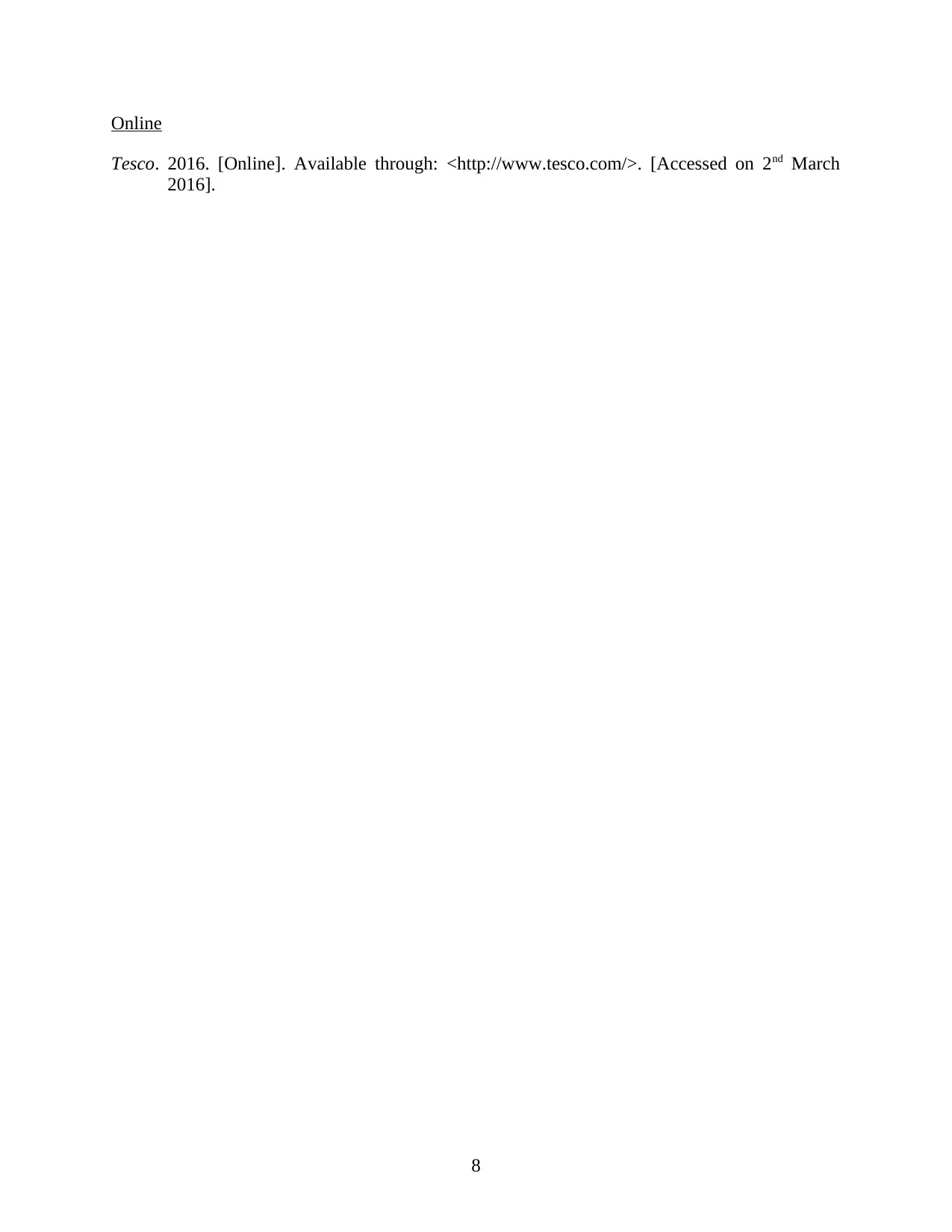
Online
Tesco. 2016. [Online]. Available through: <http://www.tesco.com/>. [Accessed on 2nd March
2016].
8
Tesco. 2016. [Online]. Available through: <http://www.tesco.com/>. [Accessed on 2nd March
2016].
8
1 out of 10